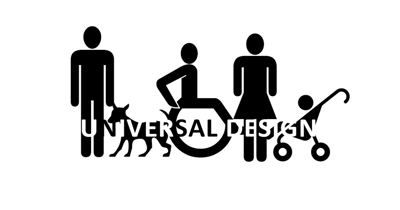
In 2015, there were roughly 53 million Americans1 who were disabled either in mobility, in hearing, or with their vision. Moreover, there are the aging baby boomers with special needs, mothers with strollers, and an increasing number of people using service dogs who each have different accessibility needs to public places. Whether you are a restaurant, retailer, bank, medical office, or school (to list a few), you likely already have Americans with Disabilities Act (ADA) standards to meet when you build a new building or remodel your existing one; however, if you aren’t already regulated by Title II or Title III, there are still benefits of planning your building for access to everyone, also known as Universal Design, which is different from ADA. Some are considering Universal Design an emerging concept of good citizenship, much the same way LEED has done for reducing a company’s carbon footprint. Compared to ADA which is mandated by the government to provide accessibility for disabled people within publicly used buildings, Universal Design is a choice that a building owner makes to include accommodations not regulated by the ADA to provide easy accessibility to everyone.
Going beyond ADA requirements and adopting Universal Design as a customer service practice can help you target new customers (or staff members) and also assist in marketing messages, “Hey, we’re here for everyone! And we’ve taken measures to make sure you can easily shop here!” Such things as having a clear approach to your building, an elevator, wider aisles, open spots for wheelchairs at tables or other seating areas can be enjoyed by many and a relief for disabled people.
For instance, years ago we worked with a national retailer on several of their Michigan stores to design and remodel required ADA updates to their restrooms. And now through their current and vast remodeling efforts to update their stores, they’re meeting their ADA requirements and incorporating even more Universal Design elements, including: public accessibility, clear paths from the parking lot, expanding doorways, communicating barrier free assistance through labels and arrows, adding braille signage on restroom signs, updating counter heights, expanding turning radiuses in the restrooms, and making space for wheelchairs at select tables. Some of these items are required, but not all of them are, our client is considering the usage of all its customers for easier access.
In addition, another long standing client incorporated a whole new business model by expanding through partner programs designed for children with special needs—becoming the only entity like it in Michigan. After planning and enlisting Wolgast Architect, Rick Keith, they added a medical facility with overnight accommodations for doctors, ramps to amenities, and barrier free access for medical attention to their existing establishment, which has helped them to enhance their entire program, and further realize their mission as an organization.
Finally, being inclusive through Universal Design is undoubtedly more expensive than not including those measures; however, it can help you when it’s time to sell your business or building. For some businesses, remodeling now to include mandated ADA changes and beyond (i.e. Universal Design) can be sound business for customer service and the long term use of your building.
1 www.cdc.gov/media/releases/2015/p0730-us-disability.html, “53 million adults in US live with disability”.

